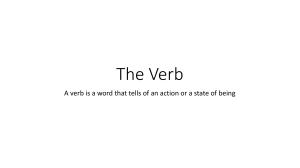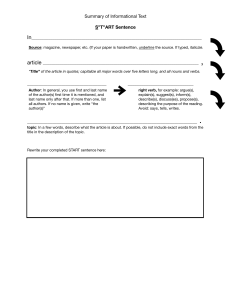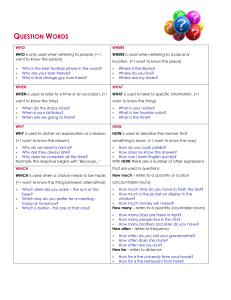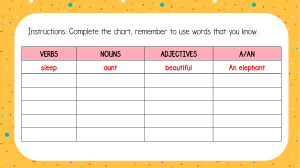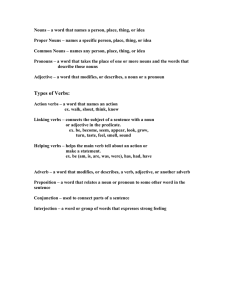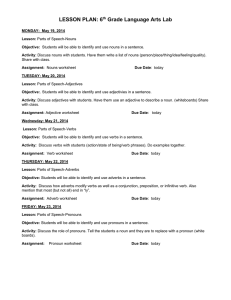Nouns & Pronouns: Definition, Types, Examples | English Grammar
advertisement
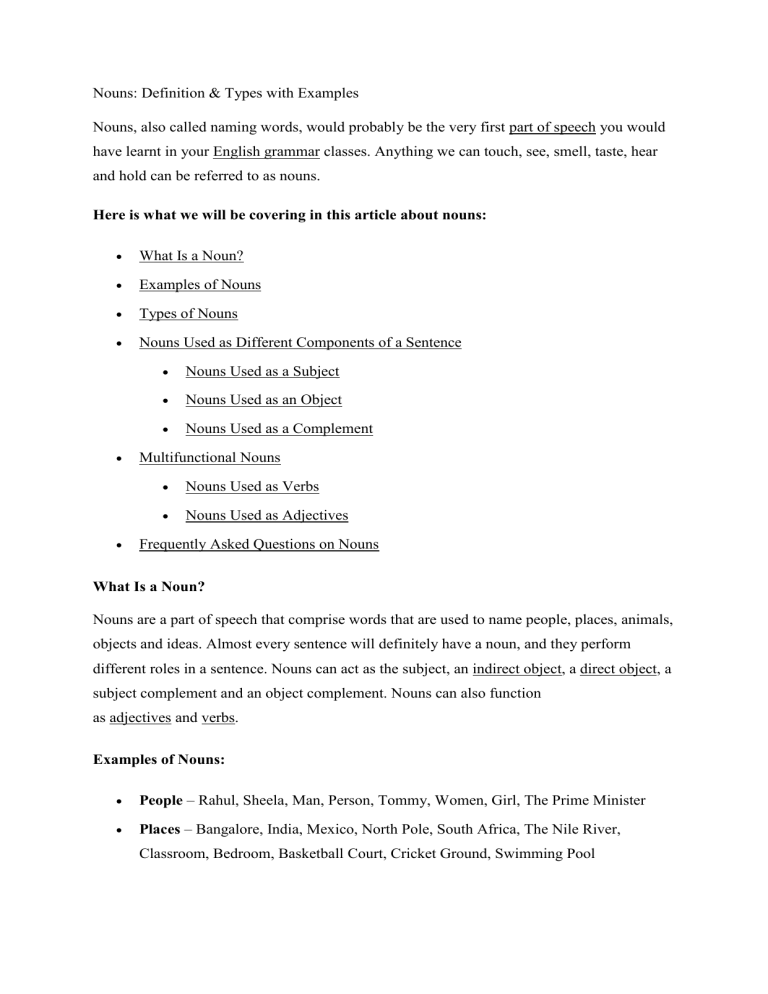
Nouns: Definition & Types with Examples Nouns, also called naming words, would probably be the very first part of speech you would have learnt in your English grammar classes. Anything we can touch, see, smell, taste, hear and hold can be referred to as nouns. Here is what we will be covering in this article about nouns: What Is a Noun? Examples of Nouns Types of Nouns Nouns Used as Different Components of a Sentence Nouns Used as a Subject Nouns Used as an Object Nouns Used as a Complement Multifunctional Nouns Nouns Used as Verbs Nouns Used as Adjectives Frequently Asked Questions on Nouns What Is a Noun? Nouns are a part of speech that comprise words that are used to name people, places, animals, objects and ideas. Almost every sentence will definitely have a noun, and they perform different roles in a sentence. Nouns can act as the subject, an indirect object, a direct object, a subject complement and an object complement. Nouns can also function as adjectives and verbs. Examples of Nouns: People – Rahul, Sheela, Man, Person, Tommy, Women, Girl, The Prime Minister Places – Bangalore, India, Mexico, North Pole, South Africa, The Nile River, Classroom, Bedroom, Basketball Court, Cricket Ground, Swimming Pool Animals/Birds/Aquatic Animals/Reptiles – Lion, Zebra, Snake, Ostrich, Flamingo, Bear, Cat, Fish, Shark Ideas – Evolution, Invention, Extinction, Argument, Destruction Objects/Things – Bat, Cycle, Curtains, Paper, Bag, Blackboard, Cupboard Types of Nouns Nouns can be broadly classified into: 1. Proper Nouns: Nouns that are used to name a person, place or thing specifically are called a proper noun. Proper nouns always begin with a capital letter. Examples: 1. 1. My name is Rose. (Name of a particular person) This is my dog, Bruno. (Name of a specific pet animal owned by someone) David came back from Minsk. (Name of a specific place) Louis Philippe is a famous brand of men’s clothing. (Name of a particular clothing brand) 2. Common nouns: Common nouns are those nouns that refer to a generic item, group or place. This means that, unlike proper nouns, they are not used to identify specific people, places or objects. Common nouns are not capitalised unless they appear at the beginning of a sentence. Examples: 1. 1. I bought a pen yesterday. (Common object) I am going to school. (Common place) Only ten employees showed up to work today. (Common group) The car is out of fuel. (Common items) 3. Singular nouns: These are words that are used to name a single person, place, animal, bird or object. Examples: 1. 1. There is a little boy in front of our house. (Single person) That is my daughter. (Single person) I found a wounded sparrow in the bush. (Single bird) A red van has been following us for a long time. (Single object) 4. Plural nouns: Plural nouns refer to a number of people, places, animals or things. Nouns are made plural by adding an ‘s’ or ‘es’ or ‘ies’ or ‘ves’ to the existing root word. Nouns that end with an ‘s’ remain the same. Some nouns remain the same in both their singular and plural forms, and some others have totally different spelling. Examples: 1. 1. I need some apples. Did you find the boxes you were looking for? I bought mangoes from the market. We took photos of some deer on our way. 5. Countable nouns are those nouns that can be counted or measured. Examples: 1. 1. Tom brought ten packets of lays for the trip. (specific number – ten) Mom asked me to buy a dozen eggs. (specific – dozen means twelve) I saw an aeroplane around seven in the morning. (specific – an means one) 6. Uncountable nouns are those nouns that cannot be counted. This category of nouns includes both concrete and abstract nouns. Examples: 1. 1. I have a lot of homework to do. (Not specific) I have a cup of tea. (Cannot count) We are facing terrible weather today. (Cannot count) 7. Collective Nouns: A collective noun is a naming word that is used to denote a group of objects, animals or people. Examples: 1. 1. Collective nouns for groups of animals A pride of lions A flock of sheep A swarm of bees A herd of elephants Collective nouns for groups of people A band of musicians A board of directors A crew of sailors A company of actors Collective nouns for a number of things/objects A pair of shoes A chain of mountains A fleet of ships A bunch of grapes 8. Concrete Nouns: A concrete noun refers to objects that are material and can be perceived by the human senses. Examples: The book is on the table. I had a cup of coffee. Sharon opened the windows. Hardy goes to school by bus. 9. Abstract Nouns: Any entity that cannot be perceived by the five senses of the human body are called an abstract noun. Examples: Love is a strong emotion. Honesty is the best policy. It takes a lot of courage to raise your voice and stand up against injustice. You should not misuse the freedom you are given. Pronoun Types and Examples A pronoun is a word that takes the place of a noun. A pronoun can act as a subject, direct object, indirect object, object of the preposition, or other part of speech and takes the place of any person, place, animal or thing. There are several types of pronouns: personal pronouns, relative pronouns, demonstrative pronouns, reflexive pronouns, interrogative pronouns, and possessive pronouns. Types of pronouns Personal Pronouns Personal pronouns are used to refer to a particular grammatical person: first person (I), second person (you), or third person (he, she, it, they). Personal pronouns also take different forms depending on the gender, number, and case of the noun it replaces. I, you, he, she, it, we they, me, him, her, us, and them are all personal pronouns. Example She is clever. Example Did you make a reservation for three? Example I hope you will invite them to the party. Antecedents Pronouns may refer to different persons or things ambiguously if the noun is not specified clearly in the sentence. When using pronouns in a sentence, an antecedent should be used to let the reader know what the pronoun is referring to. An antecedent is a noun or noun phrase that is mentioned at the beginning of a sentence and replaced with a pronoun afterwards. Example Sam drank most of the juice that he bought. Example The team has tried its best to achieve success. Example Many people lost their jobs because of the economic slowdown. Unclear/ambiguous pronoun antecedents Example If you arrive late to the play, she won't let you in. Example Sam sent a letter to Mark addressing the problems he encountered during his first year at school. Relative Pronouns Relative pronouns are used to connect relative clauses and independent clauses in order to add more information about people and things. Relative pronouns are placed directly after the noun or pronoun they modify. Who, whom, whose, which, that, when, and where are all relative pronouns. Example Is the man who came to look for you your father? Example She likes books that tell stories of famous people. Example That store, where we usually buy our groceries, is closed for the holidays. Who vs. whom: subject and object pronouns When to use “who” or “whom” can be confusing. While both can be used as pronouns, their usage differs. “Who” is used to refer to the subject of a sentence, while “whom” is used to refer to the object of a verb or preposition. Incorrect Whom should be elected as the leader? Correct Who should be elected as the leader? Incorrect He is the person to who I am married. Correct He is the person to whom I am married. Incorrect You didn’t specify the officer who I should give this form to. Correct You didn’t specify the officer to whom I should give this form. Demonstrative Pronouns Demonstrative pronouns are used to refer to a specific person or thing within a sentence. These pronouns can be used to indicate degrees of time and space. This, that, these, those, such, none, and neither are all demonstrative pronouns. Example He is late again. That boy is really getting on my nerves. Example She loves all kinds of sports. These include badminton and soccer. Example I don't like math or science. Neither is fun. Indefinite Pronouns Indefinite pronouns are used to refer to unspecified or general people or things. Similar to “indefinite” articles, these pronouns are used to refer to indefinite people or things. Anybody, everybody, nobody, somebody, anyone, everyone, no one, someone, anything, everything, nothing, and something are indefinite pronouns. Example No one likes to have to beg for something. Example Everyone is welcome to join the class. Example Anything is possible only if you keep trying. Reflexive Pronouns Reflexive pronouns are used to refer back to the subject of the sentence. Reflexive pronouns end in "-self" (singular) or "-selves" (plural). Myself, yourself, yourselves, ourselves, himself, herself, itself, and themselves are reflexive pronouns. Example I saw myself in the mirror. Example The book itself isn't difficult, but it's not fun to read. Example They recommend this movie even though they have never seen it themselves. Interrogative Pronouns Interrogative pronouns are used to ask questions or find out more information. Who, what, which, and whose are interrogative pronouns. Example Which essay did you like the best? Example Whose bag is this? Possessive Pronouns Possessive pronouns are used to show possession or that something/someone belongs or is associated closely with someone/something. My, our, your, his, her, its, and their are possessive nouns. These pronouns can be used to avoid writing the same word twice and therefore can make sentences more concise. Example I don't know where my sneakers went, so my sister lent me her sneakers. I don't know where my sneakers went, so my sister lent me hers. Example Your plan sounds just as exciting as my plan. Your plan sounds just as exciting as mine. Definition of a Verb The Oxford Learners’ Dictionary defines a ‘verb’ as “a word or group of words that express an action (such as eat), an event (such as happen) or a state (such as exist)”. According to the Cambridge Dictionary, a ‘verb’ is defined as “a word or phrase that describes an action, condition, or experience”. The Collins Dictionary provides a much more elaborate definition of a verb. According to them, “A verb is a word such as ‘ sing’, ‘ feel’, or ‘ die’ which is used with a subject to say what someone or something does or what happens to them, or to give information about them”. General Classification of Verbs according to What They Signify Before we get into a broad classification, let us first have a look at how verbs can be classified generally according to what kind of action they signify. Verbs Referring to Actions Verbs referring to action (action verbs) are those that involve the movement of one’s body in one way or the other. Some examples of verbs referring to actions are as follows: Walk Run Talk Sit Read Write Jog Cough Sleep Jump Sing Drink Teach Present Build Break Tow Toss Hug Fight Verbs Referring to Experiences or Feelings These are verbs that refer to something that you can feel or experience and do not necessarily involve a movement of any kind. Some examples of verbs referring to feelings and experiences are as follows: Love Hate Envy Believe Trust Feel Entrust Experience Care Cherish Sense Know Recognise Understand Comprehend Like Need Adore Loathe Appreciate Verbs Referring to a State or Condition These verbs are those that refer to situations or the state of being. All forms of ‘to be’ verbs belong to this category. Some examples of verbs referring to a state or condition are as follows: Am Is Are Was Were Have Has Will be Appear Seem Become Been Being The Various Types of Verbs with Examples Verbs can be classified into numerous types according to their function or role in a sentence or context. Let us look into the various types of verbs and some examples of each type of verb. Auxiliary Verbs/Helping Verbs Auxiliary verbs or helping verbs, as the name suggests, is a verb that is used to help another verb sound sensible and meaningful. It is used to change the other verb’s tense, mood or voice. So, every time an auxiliary verb is used, you always have one more verb, which acts as the main verb in a sentence. Examples of auxiliary verbs are as follows: Am Is Are Was Were Have Has Do Will Can One point you have to take care of when you use auxiliary verbs is that you should conjugate the auxiliary verb correctly according to the tense form of a sentence. Another specific fact about auxiliary verbs is that they can also be used as a main verb. Also, there are verbs called modal verbs that can be used as a helping verb. Work out exercises on auxiliary verbs to practise. Modal Verbs Modal verbs are those verbs that are used to denote the possibility, probability, capability or necessity of something happening. Modal verbs, unlike other auxiliary verbs, cannot be used as a main verb in a sentence. Examples of modal verbs are as follows: Can Could Will Would May Might Should Must Ought to Phrasal Verbs Phrasal verbs include phrases that are formed by combining two or more parts of speech that performs the same function as a verb in a sentence. In most cases, a phrasal verb results from a combination of a verb and a preposition. Some examples of phrasal verbs are as follows: Go by Lay off Log in Get off Run out Go all out Think through Fed up Taken aback Act on Back away Back up Look up Mix up Opt out Pop in Check out the list of phrasal verbs and exercise on phrasal verbs. Linking Verbs A linking verb, just like the name suggests, is a type of verb that is used to link the subjects in a sentence to the other parts of the sentence so that it is meaningful. It connects the subject to the object, an adjective and even a prepositional phrase. All ‘to be’ forms of verbs and verbs like ‘seem’ and ‘become’ can act as linking verbs. Have a look at the following examples to understand how verbs perform the role of a linking verb in sentences. Example 1: Connecting Nouns to Other Nouns in a Sentence Danny is my brother. In the above example, the verb ‘is’ is used to connect the subject ‘Danny’ as the ‘brother’ of the speaker. In this sentence, the words ‘Danny’ and ‘brother’ are used to refer to the same person. Example 2: Connecting a Noun to a Prepositional Phrase in a Sentence The children were in the park. In Example 2, the verb ‘were’ is used to connect the subject ‘the children’ to the prepositional phrase ‘in the park’. Example 3: Connecting a Noun/Subject to an Adjective Your presentation of the life cycle of the silkworm was excellent. In the above example, the verb ‘was’ is used to link the subject ‘Your presentation of the life cycle of a silkworm’ to the adjective ‘excellent’. Example 4: Connecting the Subject/Noun to the Predicate using Seem/Become This book on a treasure hunt seems interesting. In this sentence, the subject ‘This book on a treasure hunt’ is connected to the adjective ‘interesting’ with the linking verb ‘seem’. The students became bored after two continuous hours of classes and were not ready to take another hour of class without a break in between. In the above sentence, the subject ‘The students’ has been linked to the rest of the sentence with the linking verb ‘became’. Different Categories of Verbs Verbs can be divided into different categories according to their behaviour when used in a context. Let us look at the categories explained below. Regular Verbs and Irregular Verbs As you can see, verbs are used to denote actions, and they can be used in different forms to indicate when the subject in a sentence is carrying out an action. A regular verb can be conjugated to show if the action takes place in the past or if the action is taking place continuously. In most cases, the past form of the verb is formed by adding an ‘ed’ to the root verb for regular verbs. On the other hand, there are other verbs that do not follow this rule. They are called irregular verbs. These verbs have their own unique forms. If you are wondering how to learn these irregular verbs, read the article on irregular verbs to find out how. Have a look at the examples given below. Dileep searched for his white shirt in his cupboard, but he did not find it. (Root verb – search) Did you find the book you were looking for? In the above examples, the verb ‘searched’ is the past form of the regular verb ‘search’ by adding an ‘ed’ and the verb form ‘looking’ indicates the continuous form of the regular verb ‘look’ by adding an ‘ing’ to the end of the root verb. Selena read the book on the evolution of life on earth. Vineeth found the keys that went missing yesterday. In the above examples, the verb ‘read’ stays the same in the past form and when used as a past participle. ‘Found’ is the past form of the root verb ‘find’. Transitive Verbs and Intransitive Verbs Transitive and intransitive forms of verbs are used to denote how a verb acts when used with a direct object and an indirect object. Let us look at a few examples. Vincent gave a box of chocolates to his brother. (Indirect object – his brother, Direct object – a box of chocolates) Garry passed the water bottle to Kevin, who was sitting in the first row. (Indirect object – Kevin, Direct object – the water bottle) The little girl ran around the park for two hours. Francey walked to school every day. My mom cleaned the house today. (Direct object – the house) Seena did not like the movie. (Direct object – the movie) In the above examples, the verbs ‘gave’ and ‘passed’ in the first two sentences are seen to take a direct object and an indirect object, whereas the verbs ‘ran’ and ‘walked’ take no object at all. In the last two sentences, the verbs ‘cleaned’ and ‘did not like’ take a direct object and no indirect object. Verbs that take a direct object alone are called transitive verbs, and those verbs that do not take either a direct object or an indirect object are called intransitive verbs. ADJECTIVE An adjective is a describing word. Adjective describes a noun or a pronoun. The red carpet. Deep thoughts. A busy street. She is beautiful today. ☛Adjectives have different endings. Some adjectives end in -ful or -less. careful, colorful, harmful, faithful, hopeful. careless, colorless, harmless, faithless, hopeless. ☛Some adjectives end in -y. a noisy room, a rainy day, a dirty carpet. ☛Some adjectives end in -ive. a creative person, an active hour, talkative person. ☛Some adjectives end in -ing. a smiling face, loving parents, a caring doctor. ADVERB A word that describes a verb, an adjective, another adverb, or a sentence. It tells you about an action, or the way something is done. ☛A lot of adverbs end in -ly. We are happily married. Tom calls me regularly. Suddenly, she knows. It’s love! ☛Many adverbs are formed by adding -ly to an adjective. How to make adjective to adverbEasy word transformation list PREPOSITION A preposition is a word that connects one thing with another, showing how they are related. Prepositions tell us about time, position or place. Some examples of prepositions are words like ‘in,’ ‘at,’ ‘on,’ ‘of,’ ‘to,’ ‘from.’ She is in love. Book was on the table. I am from France. He is calling to you. Where are you at? Learn more about prepositions here. CONJUNCTION A conjunction is a linking word that used to connect clauses or sentences. For example and, or, but, as, if. Conjunctions are used to connect words, phrases, and clauses together. a teacher and students. a male or female? ☛Words such as before, after, as, when, while, until, since, are conjunctions of time. Maryam could play guitar before she was four. She always brush her teeth after eating her meal. There are four categories of conjunctions: Coordinating conjunctions: for, and, nor, but, or, yet, so. Correlative conjunctions: both/and, either/or, neither/nor, not only/but, whether/or. Subordinating conjunctions: after, although, as, as if, as long as, as much as, as soon as, as though, because, before, by the time, even if, even though, if, in order that, in case, in the event that, now that, once, only, only if, provided that, since, so, supposing, that, than, though, till, unless, until, when, whenever, where, whereas, wherever, whether or not, while. Conjunctive adverbs: however, therefore. INTERJECTION An interjection is a word that expresses an emotion, sudden, strong feeling such as surprise, pain, or pleasure. ☛It is often followed by an exclamation point. Cheers! Ouch! Oh my God! Oh dear! Good luck! Help! Gosh! Hey! Look out!
